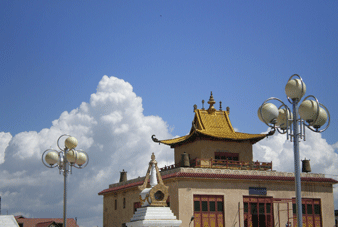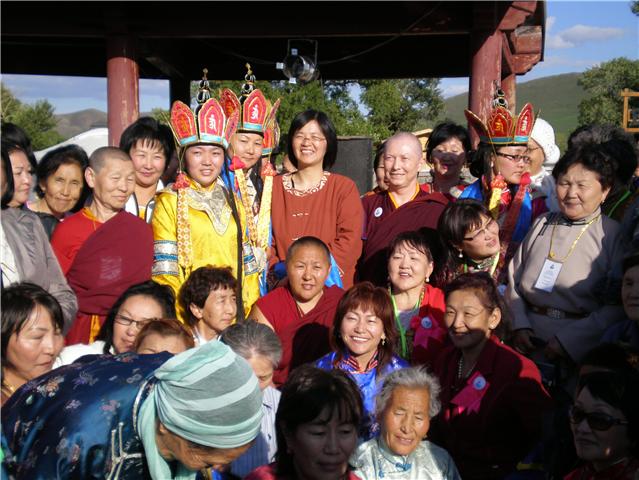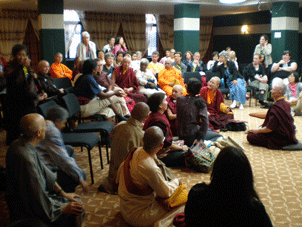
The 10th Sakyadhita International conference was held in Ulaan Bataar, Mongolia from July 1 to July 7, 2008. It had taken two years to prepare for the conference, and no one had expected to go through a very unique experience during the international conference: a riot against the unfair national election right after the opening ceremony of the international conference, which took place on July 1. Some participants who had arrived before the conference at the end of June already felt the very tense atmosphere for the election. However, what made the conference committee nervous wasn’t the election but the last minute change of the conference venue from downtown Ulaan Baatar to the suburban area. In the end, it was decided that the opening ceremony would be held in the Central Palace of Culture located in the Baatar Square in downtown Ulaan Baatar. But, the rest of the conference (from day 2 to day 7) would be held in the Hotel Mongolia which was a forty minutes drive from downtown. The hotel is located in front of a mountain with a river flowing around. Besides, it is like an antique city surrounded by walls and the style of rooms is that of the Mongolian ger (the traditional Mongolian dwelling), though the room rates are not cheap.
For the 150 international participants from 25 countries, they only needed to take the bus from the hotel to downtown Ulaan Baatar for the opening ceremony on the first day, but for the rest of the conference days, local Buddhist participants (about 250 of them) had to go from town to the Hotel Mongolia every day.
The opening ceremony went smoothly, and the important leaders in the Mongolian Buddhist Community, the officials of Religious Culture Department, and the officers of the Department of Women’s affairs (mostly women) attended the conference and took turns introducing the history of Buddhism in Mongolia.
In addition, some famous singers and dance troupes performed unique Mongolian songs and dances during the opening ceremony. Most Mongolians were Buddhists; however, under the long-term control by the Russian Communist Party, many temples were confiscated to become museums or disused. It has been 17 years since Mongolia gained independence from Russia; so many monasteries and projects have been reconstructed and reorganized by several international communities. There are many international Buddhists supporting and reviving Buddhism in Mongolia, including one of the main supporters of this conference, Mr. Ueli, from Switzerland who is in charge of the Mahayana Center in Ulaan Baatar, who helped find donors for lunch in the opening ceremony.

In fact, the reason why Sakyadhita chose Mongolia to hold the 10th Sakyadhita international conference was to help promote the revival of Buddhism and to encourage Mongolian Buddhist women. After the opening ceremony, we walked by the Communist Party Headquarters and to the restaurant at the corner of the Central Palace of Culture for lunch. Amazing! We were even able to have feta cheese and fresh fruit salad there. (Vegetarian foods are a luxury in Mongolia because most Mongolians engage in livestock industry for a living.) Over lunch everyone was busy in engaging in discussion about the conference and meeting old friends. On the way back to the hotel, we saw the gathering of crowds and felt the restlessness in the air. The first day, the conference ended at five PM. After long delays arriving at the hotel due to traffic jams, we received the phone call from the city – there was a riot taking place in the square. The Central Palace of Culture and the restaurant were both damaged by the protesters. Besides, there was a rumor that the tourist hotels in town where we had been a few hours ago were also attacked, and then the internet connection was gone. It seems that the last minute change of the conference venue was actually secretly arranged by the Buddha and Bodhisattvas!
The Mongolian government declared martial law for four days, but Mongolians still could come to the conference. We meditated in the morning sunlight at six, enjoyed breakfast at seven, and joined the conference at eight in the well -ventilated restaurant which was like the temple of heaven located in the center of the hotel. We had our lunch on the terrace of the restaurant at eleven, and in the afternoon everyone sat in circles in the restaurant or on the terrace to proceed with group discussions. Dinner was not offered by the conference.
Participants could take a walk in the farm by a river in the afternoon or stayed in their rooms to enjoy their own food. When it was 7:30 PM, everyone got together again to join workshops (e.g. cultural performances of different countries, the Kuanyin dance, and video viewings). After the evening meditation, we could see lots of shining stars and the Milky Way in the sky. There were some wedding banquets and celebratory firecrackers over the weekend. Although we were exhausted after the whole day’s conference and interpretation work, we were reluctant to part from the beautiful scenery to go to bed.
The Taiwan team impressed the participants because we were the busiest during the conference. Somebody even asked, “Was this conference arranged by Taiwan?” Last year, Prof. Christie Chang, the Vice President of Sakyadhita, accompanied Ven. Karma Lekshe Tsomo, the President of Sakyadhita, to go to Mongolia to prepare for the conference. They cooperated and established good partnerships with local Buddhist communities and volunteers. The young Taiwanese volunteers, Jack and Sandy, could go to Mongolia to help with translation work and conference affairs due to some Bhiksunis/Bhiksus and laywomen/laymen’s generous donation. The translation equipment was brought in by the eight Taiwan participants (They were Yuying Chen, Xiuyian, Yijin Hsieh, Huiying Huang, Meihuai Chen, Ven. Chao Hwei, Prof. Weiyi Cheng and me). Because there was a strict limit for luggage weight, we did our best to space our luggage for the transmitters, receivers, recharging machines and batteries, and then we passed through the customs clearance smoothly. During the conference, we had to distribute and check out the translation equipment every day and recharge the batteries every night. In addition, we had to make sure that the interpreters for the different languages got the transmitters and the papers in time, so the Taiwan team decided to set up a reception table at the entrance. As a result, everyone came to the reception table for any inquiries (e.g. looking for Prof. Christie Chang, interpreters, and so on). The last one who left the Business Center, the only place in the hotel equipped with one computer and one telephone, was also Taiwanese. Ven. Shengqin from Malaysia who stayed at the hotel kindly offered coffee and instant noodles to us.
The Mongolians are proud of the azure sky in their country, so the katags (a traditional ceremonial scarf used in Tibet and Mongolia) were blue instead of white and the background of the flag for this conference was also blue. In Mongolia, July is the best season for tourists due to abundantly available water and comfortable temperatures. In addition, the sunset in July is especially beautiful in Mongolia. When the weather was clear at night, firecrackers were extremely bright and even the Milky Way seemed very close as though we could walk on it. Such blue settings with golden red, silver green, light orange and dark red dresses on Mongolian friends whose black hair was braided in long pigtails decorated the conference colorfully. It was unusual for these friendly Mongolian Buddhists that they wore such fancy clothes, to attend the conference. In recent years, fashion shows have attracted lots of tourists. Models in these fashion shows are tall, slim and young wearing redesigned cheongsams, tall hats (like trumpets) and stylish clothes. Because the business center in Ulaan Baatar was bustling and women’s clothing were designed in Western styles, it seemed as if we were in a Southeast Asian city. If we didn’t attend such an international Buddhist conference, I think what we saw and heard about Mongolia would be the same with tourists. Due to the international Buddhist conference, we could see Mongolia from different viewpoints and be more closed to it by visiting the different parts of this country.

The conference in Mongolia was significant because it was also the 20th anniversary of Sakyadhita first established in Bodhgaya, India, in 1987. Chanting from different countries is a unique ritual held at the beginning of the opening ceremony at every Sakyadhita conference. This year, there were participants from Bangladesh, Nepal, Sri Lanka, Myanmar, Thailand, Malaysia, Taiwan, Korea, Vietnam, Japan, Mongolia, Tibet and India. It was the first time that the Japanese Tiantai Sect Bhiksunis participated in the conference. Some speakers and participants from Europe, America, Australia and South Africa took part in the conference every two years. Ven. Karma Lekshe Tsomo, the President of Sakyadhita, and Ven. Tenzin Palmo, were the important figures of the conference; besides presenting papers, they also led workshops and meditation teachings. Some laywomen’s presentations were also wonderful. Prof. Paula Arai’s research concerns “Domestic Zen” which is the extension of “the history of Japanese Zen Bhiksunis” and this research indicates how daily meditation soothes elderly people’s emotions. Sandy Boucher, the author of Turning the Wheel and other best-selling books, taught everyone the “Guanyin Dance”. As a folk dance, everyone formed two circles and danced following the chant “Bodhisattva.” Gestures were elegant, which simply and directly imitated Guanyin’s charity. Everyone quite enjoyed it and danced again in the cultural performance before the closing ceremony. Sandy’s paper for the conference was “From our History to our Future”(The Buddhist Peace Fellowship), reviewing American Buddhist women’s efforts over the past thirty years. Today it is common that women take the leadership in meditation centers. In fact, Sandy Boucher is also the leader of the American Buddhist women movement.
There was one panel entitled “How to teach the young generation Buddhism”, and the speaker, Jampa, gave a rap performance to show how the young generation interpreted Buddhism. His performance was followed with a burst of applause, and everyone wanted to learn his rap. Ven. Karma Lekshe Tsomo made a special arrangement so that Jampa led the group discussion on “Buddhism and Pop-culture”. Everyone discussed together and found Buddhism in fashion, music, and T-shirts. Besides, Jampa taught everyone how to release the young generation’s pressure and train them to be more patient by pop music. This team performed the traditional “praise to Sanbo” (三寶頌) of Theravada Buddhism composed in the style of English hip-hop during the small group discussion time. Master Chen’s Taichi performance also inspired participants to sing and dance. Master Chen practiced Taichi in the square every morning and her performance attracted lots of fans. Everyone got the opportunity to imitate her when she was performing the “fan dance”. At that time, we could see some elderly participants trying their best to arch their backs and lift their legs; although their gestures were not very perfect, at least they enjoyed themselves.
Panels, discussions, and cultural performances filled the schedule of the conference.
The tour of the last two days in Mongolia was going to visit the Buddhist temples in the urban area of Ulaan Baatar and “Manjusri Mountain”. Historically, the major religion of the Mongolian Kingdom was Tibetan Buddhism, and the prime ministers or even kings were Bhiksus; therefore, there were many temples in Mongolia. It is a pity that the important temples have already became national property and no Bhiksunis and Bhiksus live there anymore. Lamas live in temples near Sangha Colleges instead. Tourists were never-ending, but Buddhist bookstores were closed. Manjusri Mountain is the historical remains of lama villages situated in the wilderness, and there still remained the stone caves which housed the meditation rooms for Bhiksus in the past. Four hundred lamas gathered there for practice during the seventeenth century, but they were killed by the Russians in one night. The reasons that Russia attacked Manjusri Mountain were not only due to religious and ethnic differences but also due to the Mountain’s abundant water resources. The scenery along the way (from Hotel Mongolia to Manjusri Mountain) was broad prairies surrounded by flat mountains covered by short grass, but Manjusri Mountain was lofty and steep so there were forest and rocks protecting the water resources.
In addition, we also had the opportunity to visit three Bhiksunis’ temples and learn more about the present situation of Mongolian Bhiksunis. The first temple located in the industrial zone outside the suburban area was very traditional, and there were fewer than ten tonsured Bhiksunis dressed in Tibetan robes. Although the left room of the san-ho-yuan (a central building with two wings attached perpendicular to either side) was simple and crude, it used to be the classroom. The other Bhiksunis’ temples were located in new residential districts. Donations from laywomen/laymen are very important in supporting the temples, and increasing requirement of religious rites give Bhiksunis more responsibilities. Redecorated temples were all tall buildings, and the clothing of resident Bhiksunis is similar to the Mongolian traditional clothing. One of the temples was chaired by laywomen, but the ceremonial instruments and religious rites were still handled by Bhiksunis. Although Mongolian Bhiksunis are young (about 17 to 30 years old), the young generation was not familiar with Buddhism due to the 70-year domination of the Communist Party. There were even no female students at the Sangha College in the capital. When it comes to how to improve the development of Buddhism in Mongolia, promoting Bhiksunis’ education must be the priority.
After the two-day visiting tour, 150 participants continued on to the border between Mongolia and Russia to explore the traditional sights of “Russia”. The Taiwanese participants split into two groups at Seoul International Airport: some went back to Taiwan and the others stayed on to visit Korea. Because I still had other things to deal with, I was absent from the two visiting tours.
The best harvest of the Mongolian conference I got was making new friends and getting together again with old friends. The devout Buddhist laywomen abroad were great, and I have gained so much from them through communicating and sharing the life experiences and changes of the recent two or three years and also received their recently published books and videos. After every Sakyadhita conference, I have the same feeling that I still need to make an extra effort to improve my English ability. I look forward to the 11th Sakyadhita International conference in Vietnam from Dec. 28, 2009 to Jan. 3, 2010.
Yu-Chen[[Li Associate professor, Department of Chinese, National Tsing Hua University.]]




